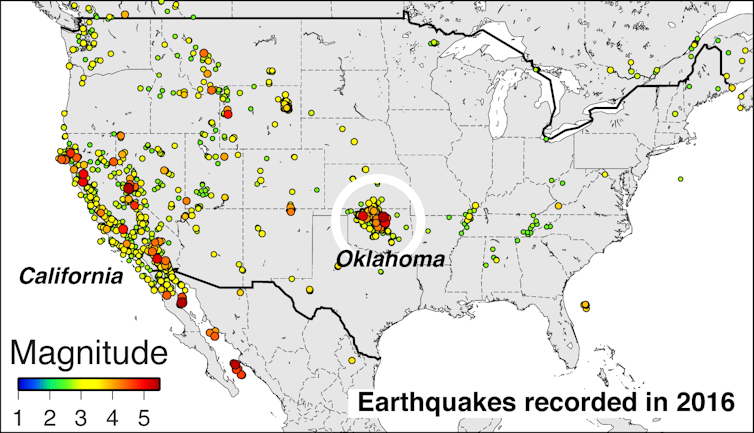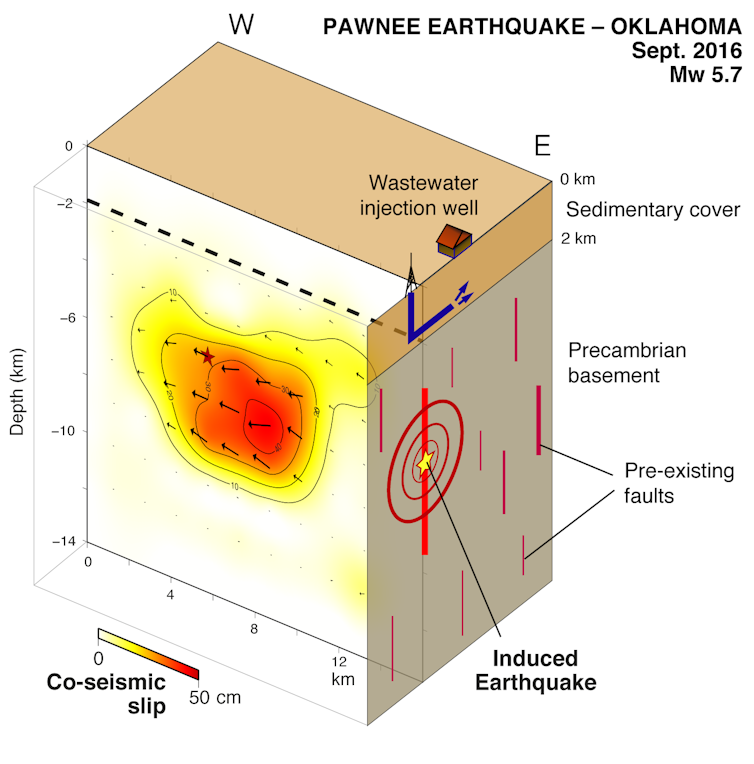New findings on earthquakes and oil and gas extraction in the United States – CWEB.com

Robin Lacassin, Institut de physique du globe de Paris (IPGP) — USPC and Raphael Grandin, Institut de physique du globe de Paris (IPGP) — USPC
In recent years Oklahoma has become one of the most seismically active regions in the United States. This is surprising given that the state is located on the edge of the Great Plains, far away from the boundary of any tectonic plates. Yet 2015 was an exceptional year, with more than 800 earthquakes of magnitude 3 or greater. This is in marked contrast to the period before 2009, when only one earthquake of magnitude greater than 4 was recorded… every 10 years.
What could explain this behavior? Oil and gas exploitation is the main culprit, as the bulk of seismic activity is induced by the injection of massive amounts of wastewater into the subsurface. The water originates from oil and gas production at shale reservoirs, where nonconventional extraction techniques are used, including hydraulic fracturing (often referred to as fracking).
Faced with this crisis, the authorities in Oklahoma have taken first steps to regulate wastewater injection. Consequently, in 2016 there was a — relative — decrease in the seismicity rate, with only 600 earthquakes.
But over the very same period, three earthquakes with magnitudes greater than 5 occurred, causing material damage. This was the case of the September 2016 Pawnee earthquake: with a magnitude of 5.8, it was the strongest earthquake ever recorded in Oklahoma. A team of scientists from Institut de physique du globe de Paris (IPGP) has just published a study on the subject.
Remote destabilization
Using seismological data recorded in the region of the Pawnee earthquake, as well as seismograms acquired thousands of kilometers from the epicenter, it has been possible to reconstruct the rupture sequence.
Observations originating from radar interferograms — computed using data acquired by the Sentinel-1 satellites of the European Space Agency (ESA) — have also been analysed. These images allow for high-accuracy mapping and measuring of ground surface deformation induced by the earthquake.
The joint analysis of these radar and seismological data indicate that slip during the earthquake reached a maximum of 40 centimeters, while being confined to a depth of between 4 to 9 kilometers. This latter finding reveals that the causal link between fluid injection and the triggering of seismic activity is not straightforward.
In fact, wastewater is being injected within the sedimentary cover at depths no greater than 2 to 3 kilometers, noticeably shallower than the earthquake’s origin. The event initiated between 4 to 5 kilometers in depth, and then spread downwards, to 9 kilometers in depth, without ever propagating toward the surface. As a consequence, under the likely assumption that the earthquake was induced by wastewater injection, the perturbation arising from this fluid injection seems to be capable of remotely destabilizing a seismic fault.

Institut de physique du globe de Paris (IPGP)
Two mechanisms at play
Two physical explanations can be given to account for such a remote triggering.
First, changes in the pressure of fluids trapped in the host rock can be transmitted through the medium, using fractures that are naturally present in the crust to facilitate fluid circulation. Fluids under pressure due to the injection may “push” other fluids located further away from the injection point, forcing them to migrate outward. With time, a pressure “wave” would expand in concentric circles around the injection wells, eventually giving rise to an increase of interstitial pressure in the heart of seismic faults nearby.
Another mechanism primarily involves the tendency of rocks to deform elastically over short time scales (from a few days to several months) around injection points due to fluid pressurization, thereby indirectly affecting the fluids. Akin to a sponge, “squeezed” rocks (even if slightly squeezed) will release fluids that will eventually migrate towards less stressed regions in the surroundings. This fluid migration can also trigger earthquakes.
In Oklahoma, recent legal requirements instruct operators to report injected volumes on a daily basis. This could provide a means for quantifying, using numerical models, the pressure increase on nearby faults. If one wishes to anticipate the occurrence of an earthquake, it may suffice to monitor the faults located in the vicinity of injection wells. Unfortunately, this approach would be subject to high uncertainty due to a poor knowledge of the fault network that has the ability to convey fluids from injection zones up to seismogenic faults. The interaction between several competing physical mechanisms further complicates the understanding of the phenomenon of induced seismicity.
Ancient faults
But a bigger challenge remains to be overcome. The Pawnee earthquake case study further reveals that the fault involved in the earthquake had never been mapped prior to the event. The discovery of a new fault after an earthquake is no surprise. In fact, an a posteriori identification is frequently reported in the literature: before it breaks, a seismic fault often remains silent.
In Oklahoma, this lack of knowledge of the fault network raises a major difficulty because the maximum size of induced earthquakes is mainly controlled by the length of the faults that are available to seismically release stress. As faults are poorly mapped, estimating the magnitude of future earthquakes becomes very uncertain. Geologic studies have revealed that large earthquakes have occurred in the pre-historic past. Wastewater injection could awaken one of the faults involved in these very old earthquakes, leading one of them to break again.
Unfortunately, the extremely low frequency of these earthquakes means that it is difficulty to build an exhaustive inventory of these past ruptures, and even more difficult to anticipate an impending rupture.
In a broader perspective, the central United States has long been recognized as being subject to large, extremely damaging earthquakes, but which fortunately occur on a very infrequent basis. A prime example is the New Madrid, Mo., earthquakes that occurred in 1822 and 1823. This seismic sequence included six earthquakes of magnitudes greater than 7, and a main shock culminating at 7.5. The 2011 Virginia earthquake, with magnitude 5.8, is yet another recent warning that the region is seismically active.
A political issue
Until recent years, the weak seismicity rate in Oklahoma was not considered sufficiently worrying to necessitate any particular paraseismic building codes.
Residential dwellings and public buildings are not ready to withstand seismic shaking, even of moderate intensity, which makes the area particularly vulnerable. If natural seismic activity in the central United States is still difficult to understand, and even more difficult to handle, the same cannot be said of those phenomena that stem from human activities.
Reducing, or even putting a full stop to the massive injection operations carried out at the regional scale by oil companies, could lead to a drop in the seismicity rate, hence to a decrease in the related hazard.
But such a decision is in the hands of the political sphere. In this respect, the recent appointment of Scott Pruitt at the head of the Environment Protection Agency (EPA) by Donald Trump represents a tipping point.
Over the last years, Scott Pruitt, former Attorney General of the State of Oklahoma, has worked to limit federal interventions aimed to restrain the ecological impact of oil extraction activity in Oklahoma. The role of oil lobbies in providing a backdrop for the policies promoted by Scott Pruitt is subject to many questions in the local and national media.
The fact that the oil industry remains the main employer in Oklahoma further complicates attempts by the public to take a stance against wastewater injection, which can be considered as an unprecedented full-scale geophysical experience. Accounting for a human dimension in seismic hazard, where industrial, citizen, political and scientific influences are intertwined, dramatically increases the uncertainty of mitigating the effects of seismicity.
It should be noted that complex human factors do not only operate in this very particular case of induced seismic hazard due to oil exploitation in Oklahoma. A combination of scientific, technological and political responsibilities have also been highlighted in the case of the Fukushima disaster that hit Japan in 2011, which included an earthquake, a tsunami and a nuclear accident.
![]() The authors would like to thank Tara L. Shreve for her assistance in the translation of this article.
The authors would like to thank Tara L. Shreve for her assistance in the translation of this article.
Robin Lacassin, Directeur de recherche, Institut de physique du globe de Paris (IPGP) — USPC and Raphael Grandin, Maître de conférences en géophysique, Institut de physique du globe de Paris (IPGP) — USPC
This article was originally published on The Conversation.


